CSIRO Parkes radio telescope added to National Heritage List
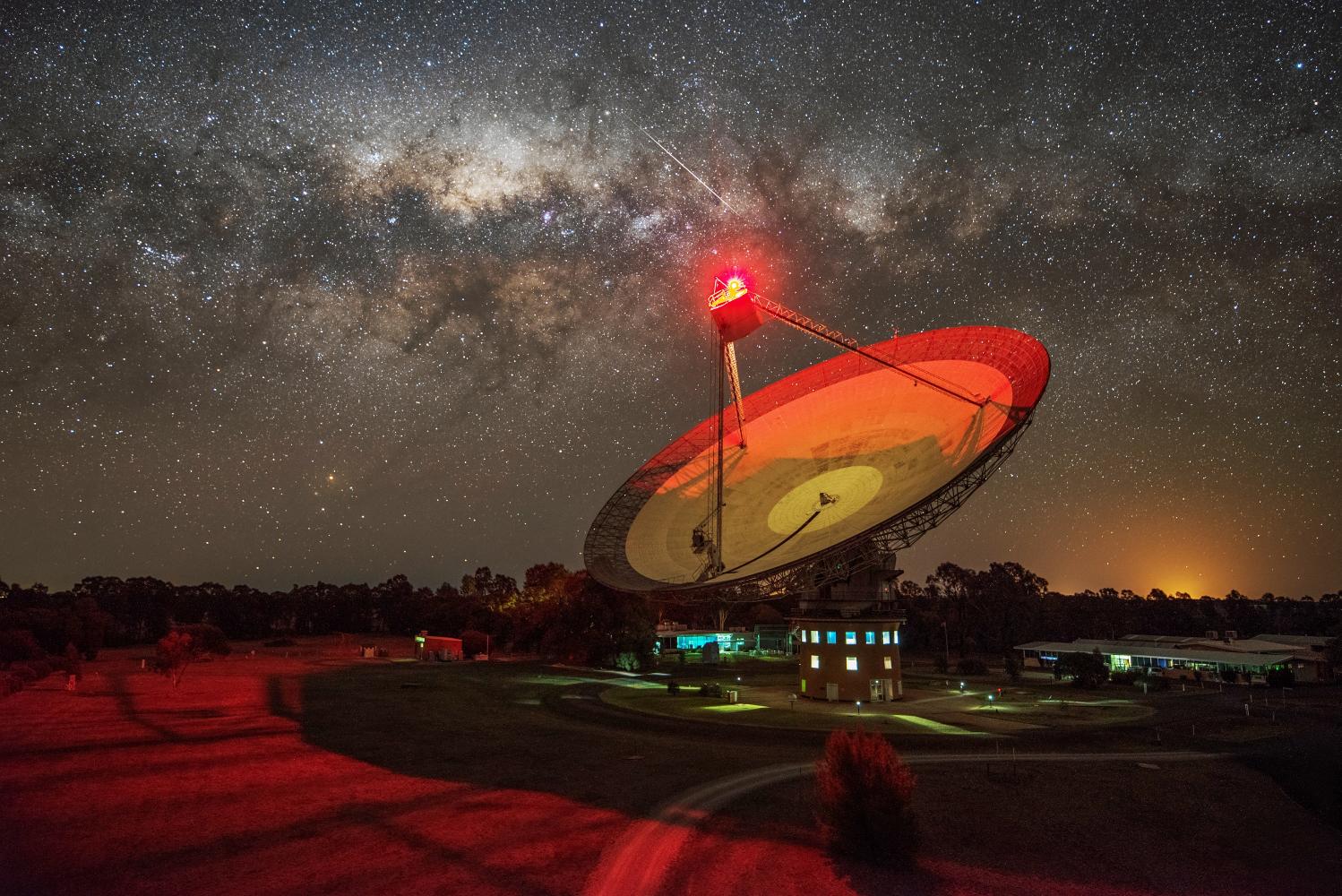
The iconic Parkes radio telescope, otherwise known as The Dish, has been officially recognised for its contribution to Australian astronomy and humankind’s understanding of the Universe with its addition to the National Heritage List.
Minister for the Environment Sussan Ley made the announcement on Monday August 10th, 2020 that the telescope, owned and operated by Australia’s national science agency – CSIRO, is the first functioning scientific instrument to be added to the list.
By the late 1940s and early 1950s it was clear that the days of improvisation in radio astronomy were over, and that the next steps had to be big ones. In turn, this implied that much planning and lots of money would be required. At the time the two strongest countries in radioastronomy were the UK and Australia.
Australia got off to a good start in radio astronomy just after the Second World War. Staff of the CSIRO Radiophysics Laboratory (later the Division of Radiophysics) made use of radio-receiving antennas and other equipment left over from war-time, and turned them from their original purpose of receiving man-made radio signals to studying the natural radio waves produced by objects in the cosmos. The equipment located on the coast at Dover Heights in Sydney was rough and ready, and often improvised (see Radio astronomy at Dover Heights). But by the late 1940s and early 1950s it was clear that the days of improvisation were over, and that the next steps had to be big ones. In turn, this implied that much planning and lots of money would be required.
The first proposal was to build a large air-warning antenna that would double as a radio telescope. The Radiophysics Laboratory had close links with the Royal Australian Air Force (RAAF): during the war it had worked for all three services (army, navy and air force) and just after the war it was advising the RAAF on radar and navigation equipment, including air-warning equipment. At the time it seemed that the best way to extend that technology would be to build larger radio-receiving antennas. Radiophysics staff began thinking in terms of dimensions of hundreds of feet. At one stage they proposed to build a wooden antenna, 100 feet in diameter, rotating on a track and costing all of A£365. A large antenna like this could be used for both air-warning and for radio astronomy. But the RAAF was even more strapped for cash than CSIRO, and had no money to put towards such a project.
In 1952 it became clear that CSIRO too had no chance of getting a large capital sum to fund such an instrument. Some way had to be found to squeeze it out of the existing Radiophysics budget. So a proposal was drawn up for a cylindrical antenna, lying on its back, 1 000 feet long and 200 feet wide, made up of five adjoining elements. Each element would be 200 feet square, lying on an east-west line and scanned by cable and winches in the north-south direction. The total cost was to be about A£125 000, spread over five years. But once again the answer was no.
Unlike Australia, the USA had been slow to take up radio astronomy after the Second World War. The leader of the Division of Radiophysics, Dr EG (Taffy) Bowen, had many contacts in science and industry in the USA, and he urged them to help the USA to take up radio astronomy, mainly by building a large radio-receiving antenna. The proposal fell on receptive ears. The Division of Radiophysics wrote a detailed specification for such an instrument and a program of scientific activities that it could be used for. It was tacitly understood that this telescope would go ahead at the California Institute of Technology, and that the Carnegie Corporation might provide up to US$5 million for it. [1.]
Given the UK were building the large 250-ft (77-m) telescope at Jodrell Bank, the Chief of the CSIRO Division of Radiophysics, Dr EG (Taffy) Bowen, proposed that Australia needed one as well.
"Radio Telescope"
LONDON, Sun.—A record-size "radio telescope" is to be built in Britain to explore the mysterious invisible "radio stars," whose existence was not suspected until scientists found they were sending out radio waves which could be picked up on the earth. "Radio Telescope" (1952, April 28). The Canberra Times (ACT : 1926 - 1995), p. 4. Retrieved from http://nla.gov.au/nla.news-article2853869
About the time that these plans for a telescope were being drawn up, the large American foundations such as Ford, Rockefeller and Carnegie were changing their emphasis in supporting science, giving less to the US and more to other parts of the world. Vannevar Bush (President of the Carnegie Corporation) and Alfred Loomis (a Trustee of both the Carnegie Corporation and the Rockefeller Foundation) suggested that the proposed large telescope be built in Australia, with financial assistance from the USA.
The Carnegie Corporation had accumulated US$250 000 that it was obliged, for certain reasons, to dispose of in the British Commonwealth, and the Corporation’s trustees granted this money towards the construction of a telescope in Australia. This grant was followed by another donation from the Rockefeller Foundation.
The last hurdle was that the overseas bodies required that their own grants be met, dollar-for-dollar, by the Australian Government. The Australian Government rose to the occasion (the money actually came from other CSIRO sources) and contributed to not only the capital costs but the running costs as well. A year later the Rockefeller Foundation gave a further US$130 000. The telescope now had an assured future and work began on ideas of what a giant radio telescope should look like.
New Rockefeller Grant For Giant Telescope
MELBOURNE, Thursday, —The Rockfeller Foundation of New York has made a further donation of 107,000 dollars (about £48,150) to wards the cost of the giant radio telescope being built for the C.S.I.R.O. at Parkes. The donation was announced by the Minister-in charge of the C.S.I.R.O., Mr. Casey, to-day.
The foundation made its first donation of 250,000 dollars towards the cost of the telescope about four years ago. Since that time the total cost estimates have risen from £500,000 to £800,000.
The construction of the huge instrument is now well advanced and the whole project will be completed in 1961.
The main component is a steel dish-shaped bowl 210 ft. in diameter which will pick up radio signals from the outermost fringes of the universe. New Rockefeller Grant For Giant Telescope (1960, January 1). The Canberra Times (ACT : 1926 - 1995), p. 4. Retrieved from http://nla.gov.au/nla.news-article103073916
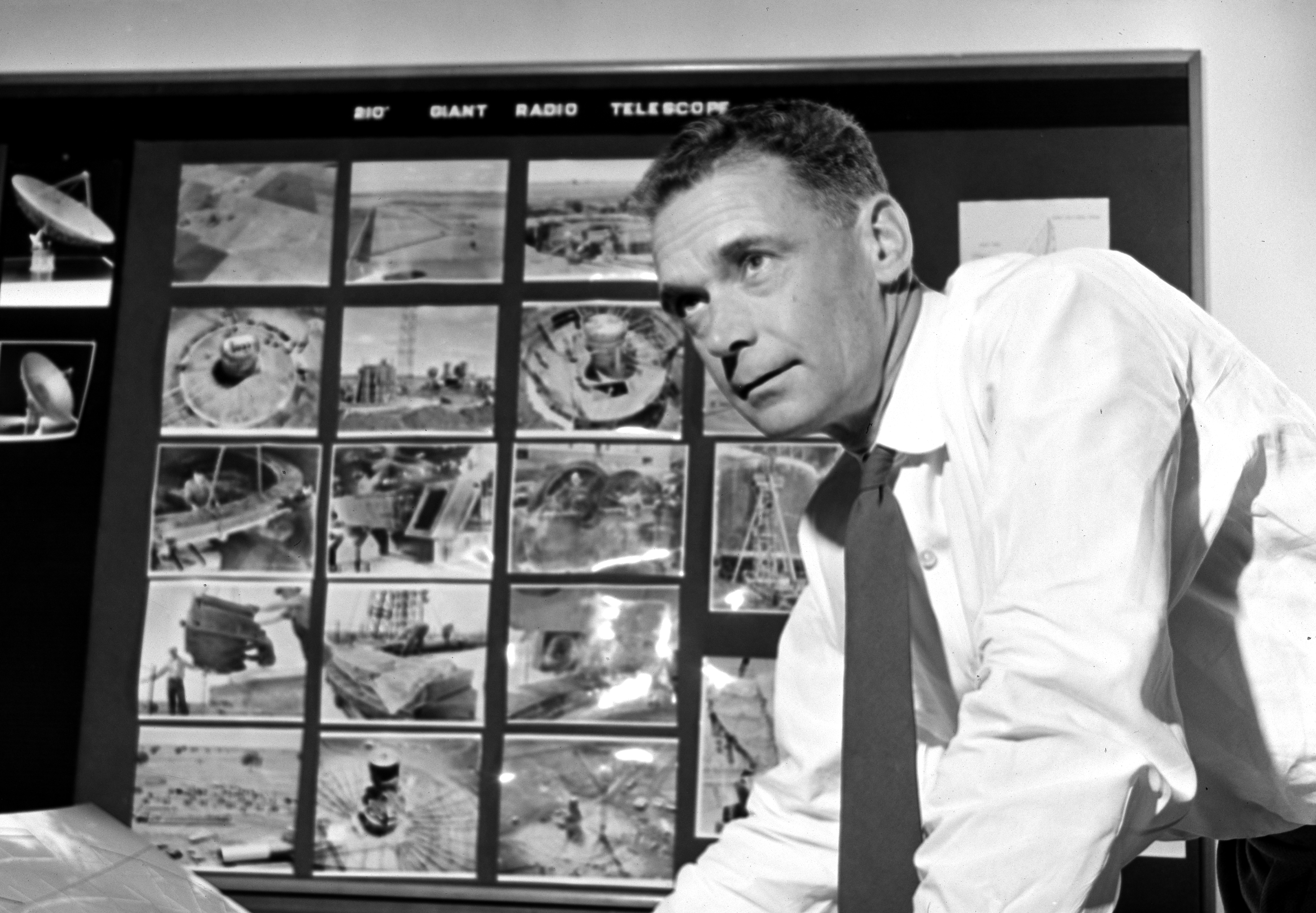
Dr E.G. 'Taffy' Bowen was CSIRO’s Chief of the Division of Radiophysics and the driving force behind the Parkes radio telescope. Credit: CSIRO
In 1954 there was no-one in Australia capable of building the Parkes telescope or even doing the engineering design. So Joe Pawsey went to Britain for advice (it was thought to be cheaper than the USA). The first person consulted was Barnes Wallis (of ‘dambusters’ fame), who was then the Chief Engineer of Vickers. Wallis was quite excited by the challenge of the proposed telescope but warned that: the design of a giant radio telescope is a venture into the unknown.
Taffy Bowen was very conscious of the dangers of this new venture and was also very good at seeking expert advice. He formed a Technical Advisory Committee (TAC) to help select the consultants for the design study, to specify exactly what they had to do and to assess their recommendations. The TAC included a distinguished English engineer John Roderick, Professor of Civil Engineering at Sydney University and Arthur Wills, an experienced engineer at the Aeronautical Research Laboratories in Melbourne.
The design study took place from 1955-1956. Freeman Fox and Partners (FF&P) in London, was the design firm chosen. The top people involved from FF&P were Ralph (later Sir Ralph) Freeman Jnr and Gilbert (later Sir Gilbert) Roberts, FRS, a brilliant if somewhat idiosyncratic bridge engineer for the project. Roberts was the partner directly responsible for the project and had been first assistant in the 1920s to Freeman’s father, Sir Ralph Freeman Snr who was design consultant to Dorman Long in their successful tender for the Sydney Harbour Bridge and was afterwards responsible for its detailed design. Robert’s first assistant for the telescope study was MH Jeffrey. Harry Minnett was the Radiophysic’s representative at FF&P in London, available for consultation on CSIRO’s requirements, especially the radio and electrical aspects and to liaise with Sydney on problems and progress.
Bowen had arranged for Barnes Wallis to collaborate with FF&P. Wallis advised on the problems of deflection of the telescope’s structure, first by thinking of incompressible columns (he held the patent to this device) and then by recommending automatic compensation for changes to the dish’s parabolic shape (which was in fact used in the telescope). In a significant departure from the design of previous telescopes, Wallis recommended that the telescope’s mounting system (the way in which it is turned and pointed to different parts of the sky) be ‘alt-azimuth’, rather than, for instance, the equatorial mount used on the earlier radio telescope at Jodrell Bank in the UK. And just for good measure, Barnes Wallis came up with the idea of the telescope’s guidance system, the ‘master equatorial’. Wallis’ contributions far exceeded his very small retaining fee ‘ which, in any case, it seems was never paid. [1.]
Another important step was to find a suitable site. The people involved in the search were Lindsay McCready, Joe Pawsey and Frank Kerr. The first consideration was that it needed to be accessible from Sydney but shielded from Sydney’s radio noise. Initially they felt a distance of about 30 miles would be sufficient, but with Sydney’s subsequent expansion that would have been unsatisfactory. Areas considered in NSW were Camden, Canberra, the Kangaroo Valley near Nowra, Cowra and Parkes.
Radio Telescope
Blue Mountains City Council has offered every assistance to the Division of Radio Physics if any area of ground within the City limits is found suitable for the erection thereon of the pro posed radio telescope. The cost of the radio telescope is expected to be between £400,000 and £500,000. Radio Telescope (1954, September 16). Nepean Times (Penrith, NSW : 1882 - 1962), p. 3. Retrieved from http://nla.gov.au/nla.news-article100986485
In the end the Cowra/Parkes options were the only possibilities considered feasible. The Cowra site was at a point beside the Macquarie River and looked promising but the Parkes site was better because it had more flat ground.
After a preliminary planning stage, the design study was carried out with Freeman Fox and Partners, London from 1955 to 1956 and the design contract from 1956 to 1959. Construction started in 1959;
Giant Radio Telescope
The contract for the C.S.I.R.O.'s giant radio telescope, which is to be located at Parkes, N.S.W., has been placed with the German firm of Maschinenfabrik Augsburg — Nuernberg A.G. (known as M.A.N, for short), the Minister in Charge of C.S.I.R.O. (Mr. R. G. Casey) announced recently.
Tenders for the construction and erection of the giant radio telescope were called throughout the world, Mr. Casey said.
British, American and German firms submitted tenders. The lowest and most satisfactory'tender was from M.A.N, in Germany.
M.A.N. will be placing a sub-contract in Australia for part of the work.
Mr. Casey said that Dr. E. G. Bowen, Chief of C.S.I.R.O.'s Division of Radiophysics, had played a- leading part in getting the design of the radio telescope finalized and in arranging for the calling of tenders.
Total cost of the giant radio telescope project will not be far short of £A750,000, Mr. Casey said.
Generous gifts to C.S.I.R.O. from the U.S.A. (from the Rockefeller Foundation and the Carnegie Corporation) and from industry and from, private donors in Australia have made the construction of the radio telescope possible.
Mr. Casey said that the Commonwealth Government is matching these, donations to provide the total needed.
The giant radio telescope will be erected at Parkes, N.S.W., about 200 miles west of Sydney. The radio telescope is expected to be completed early in 1961, Mr. Casey said.
Work to prepare the site at Parkes is already in hand, and M.A.N. will start to erect the radio telescope there about the middle of 1960.
Mr. Casey said that Australia had already played a pioneering part in the development of radio astronomy. The new radio telescope will enable Australian scientists to maintain the prominent position that their work has won in this new and important branch of science.
The most spectacular feature of the giant radio telescope will be its radio "mirror," a saucer-shaped bowl 210 feet in diameter and covered in wire mesh. This "mirror" will pick up radio signals from the outermost fringes of the universe. This "mirror" will be slightly smaller than that of the only other giant radio telescope in existence (at Jodrell Bank, near Manchester, England). However the surface accuracy of the Australian radio telescope and the precision with which it can be pointed and driven will all be substantially higher.
These are the most important features in a radio telescope and the Australian instrument is likely in practice to be the most advanced and the most powerful of its kind in the world.
Giant Radio Telescope (1959, July 24). Western Herald (Bourke, NSW : 1887 - 1970), p. 11. Retrieved from http://nla.gov.au/nla.news-article103996344
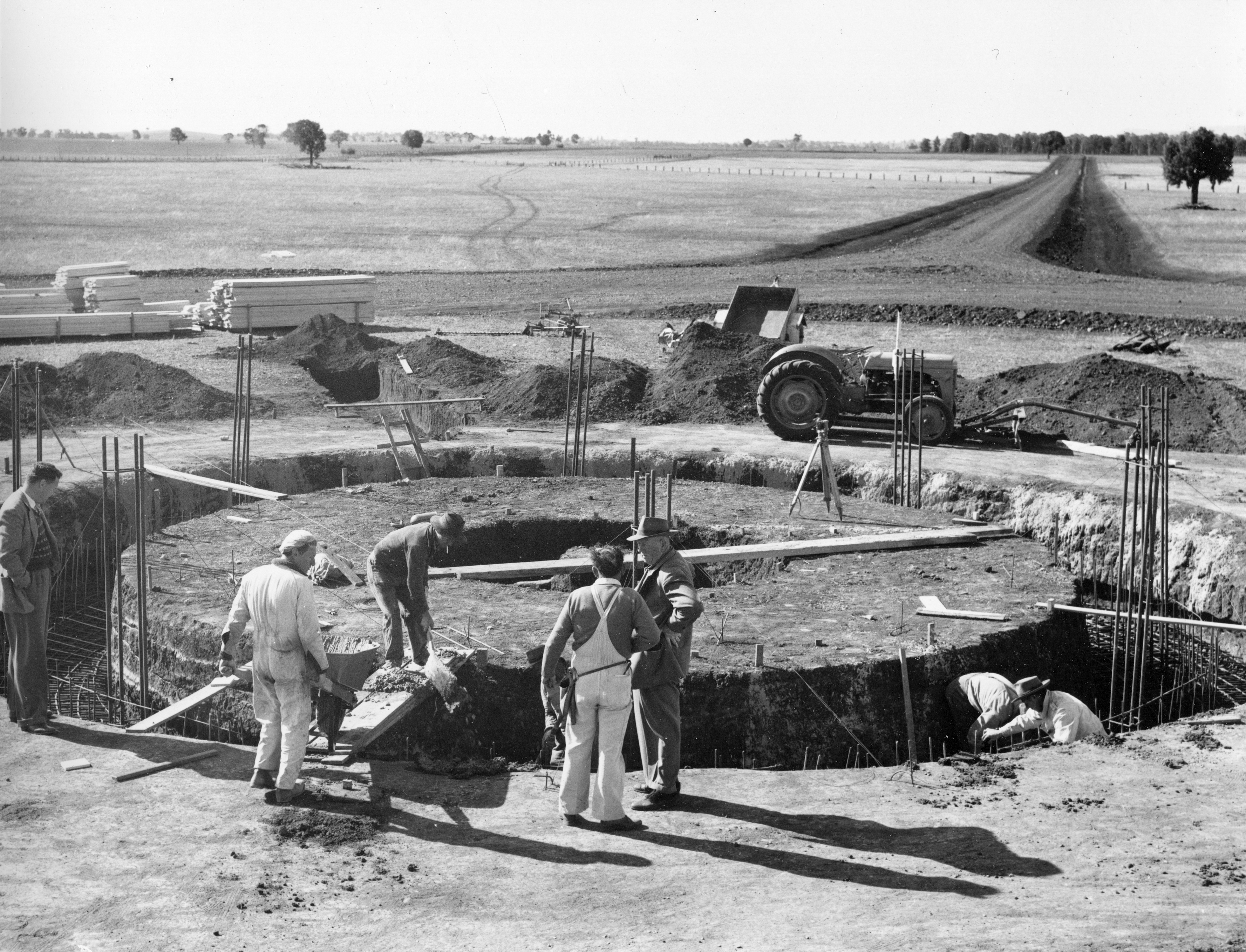
CSIRO’s Parkes radio telescope during construction Credit: CSIRO
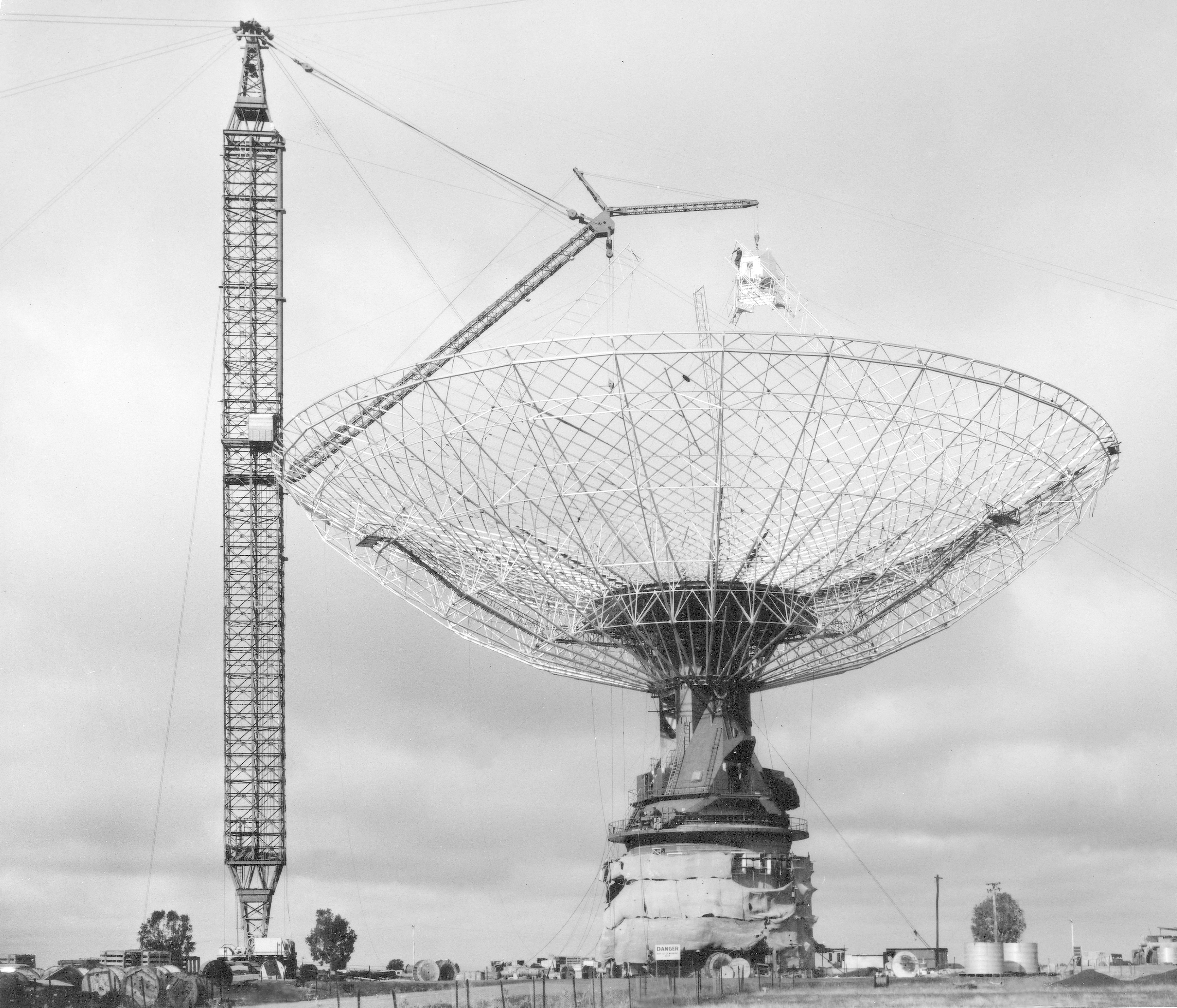
CSIRO’s Parkes radio telescope during construction Credit: CSIRO
The telescope was officially opened on October 31st, 1961 by the Governor-General, Viscount De L’Isle.
Almost sixty years later, it is still one of the most advanced telescopes of its kind. A gigantic structure of steel and concrete, the telescope soars nearly 55 metres into the sky near Parkes, NSW.
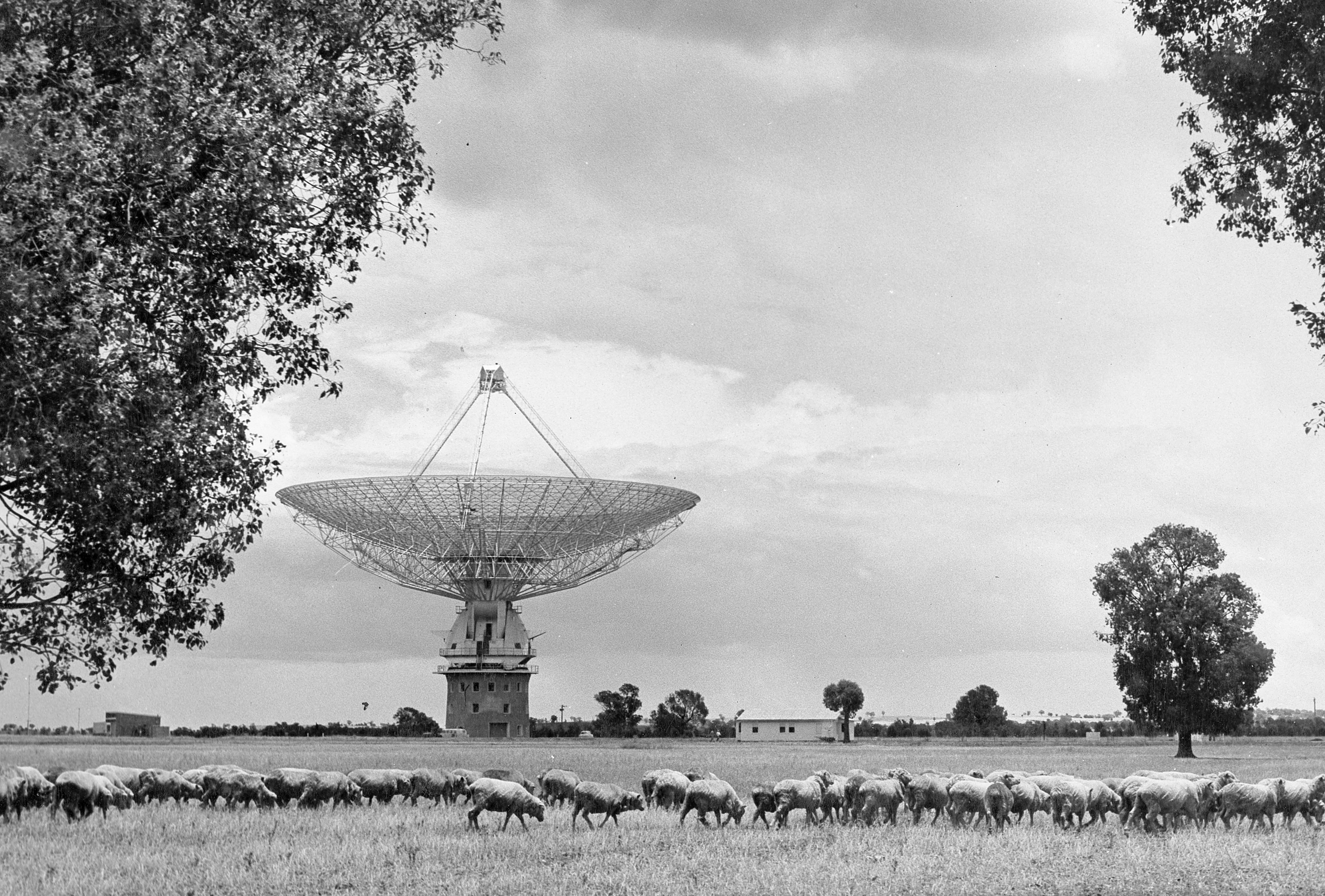
CSIRO’s Parkes radio telescope shortly after its completion in 1961 Credit: CSIRO
PARKES RADIO TELESCOPE
A Visitors Centre being constructed at the site of the Parkes Radio Telescope should be open to visitors from the middle of August.
The Centre will be equipped to provide interesting information about the Radio Telescope and the work on which it is engaged, and will feature a true-to-scale working model of the 210 ft. 'scope which visitors will be able to operate for themselves. The Centre will be open every day of the week: 8.30 a.m. to 4.30 p.m. Mondays to Thursdays, 8.30 a.m. to 2.30 p.m. on Fridays, and 9 a.m. to 4.30 p.m. Saturdays and Sundays. The former regular inspections of the Radio Telescope itself between 2-4 p.m. on Sunday afternoons have been discontinued. PARKES RADIO TELESCOPE (1968, August 2). Western Herald (Bourke, NSW : 1887 - 1970), p. 8. Retrieved from http://nla.gov.au/nla.news-article142505887
The Parkes radio telescope continues to be used by Australian and international astronomers in the search for answers to some of the Universe’s greatest scientific questions.
The telescope is best known, however, for its role in supporting NASA’s missions to explore our Solar System.
In July 1969, alongside NASA’s Honeysuckle Creek Station near Canberra, the telescope played a key role in receiving the television signals from the Apollo 11 mission to the Moon and sharing this technological feat with 600 million people around the world.
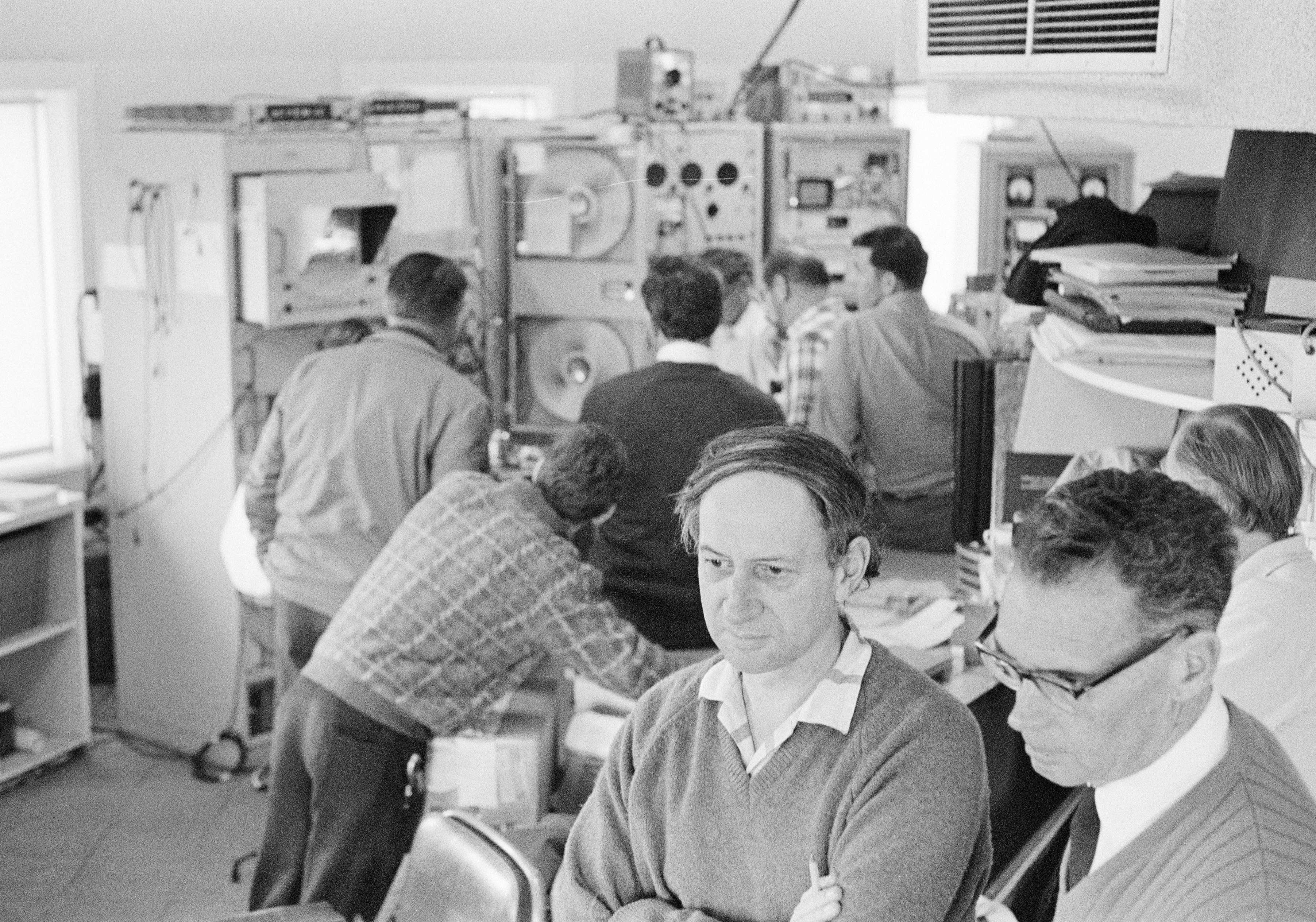
Inside the telescope during the Apollo 11 moonwalk. Credit: CSIRO
The 50th anniversary of the Apollo 11 Moon landing on July 21st was celebrated in 2019, and included NASA gifting the only official copy of the footage held outside of the United States to CSIRO, while the movie 'The Dish', a 2000 Australian historical comedy-drama film that tells the story of the Parkes Observatory's role in relaying live television of humanity's first steps on the Moon during the Apollo 11 mission in 1969 was the top-grossing Australian film that year and remains popular today.
Minister for Industry, Science and Technology Karen Andrews said this week the Parkes Observatory is a key part of Australia’s scientific capability.
“The Dish is part of Australia’s proud cultural and scientific history and to this day continues to serve as an important tool in our understanding of the Universe,” Minister Andrews said.
“As Australia again plays a critical role in the next efforts to put people on the Moon, and go on to Mars, this listing couldn’t come at a more appropriate time.”
CSIRO Chief Executive Dr Larry Marshall said the Parkes radio telescope is an icon of Australian science and innovation.
“Australia has a long and proud history of science-driven innovation, from our first digital computer – CSIRAC, to the first air defence radar which helped to pave the way for the new field of radio astronomy after World War II, and more recently the development of fast Wi-Fi that connects people across the world to the internet,” Dr Marshall said.
“While the Parkes telescope may be old enough to qualify for the National Heritage List, it continues to operate as one of the world’s leading astronomy instruments, observing the Universe day and night, seven days a week, with the most advanced radio receiver systems in the world."
Its instrumentation has been continually upgraded so the telescope is now 10,000 times more sensitive than when it was first built.
Using the Parkes telescope astronomers have found most of the known pulsars, rapidly spinning neutron stars, and identified the first ‘fast radio burst’, a phenomenon that researchers around the world are racing to explain.
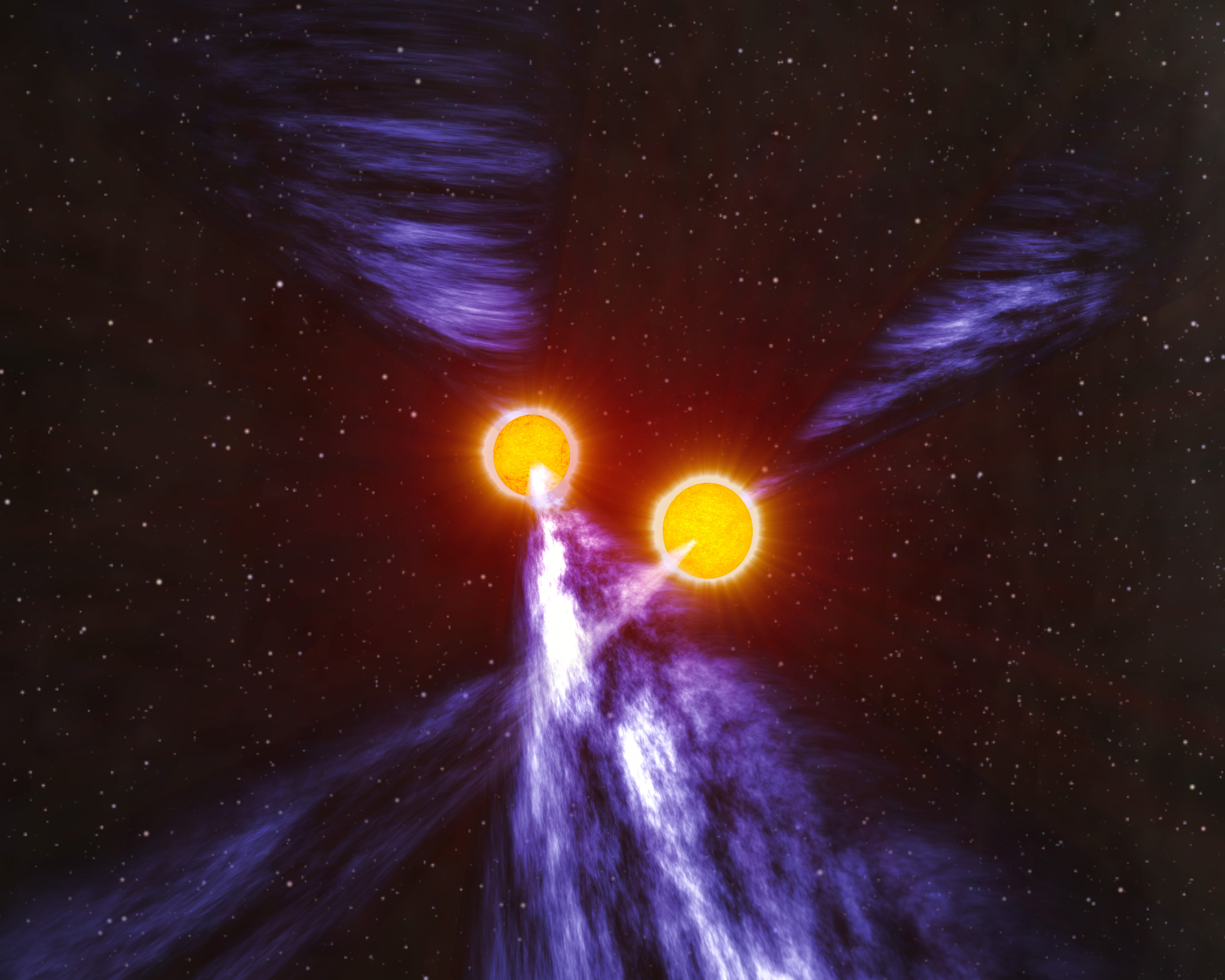
Astronomers using CSIRO’s Parkes radio telescope discovered the first known double pulsar system, which enables stringent tests of Einstein’s Theory of General Relativity Credit: CSIRO/John Rowe Animation.
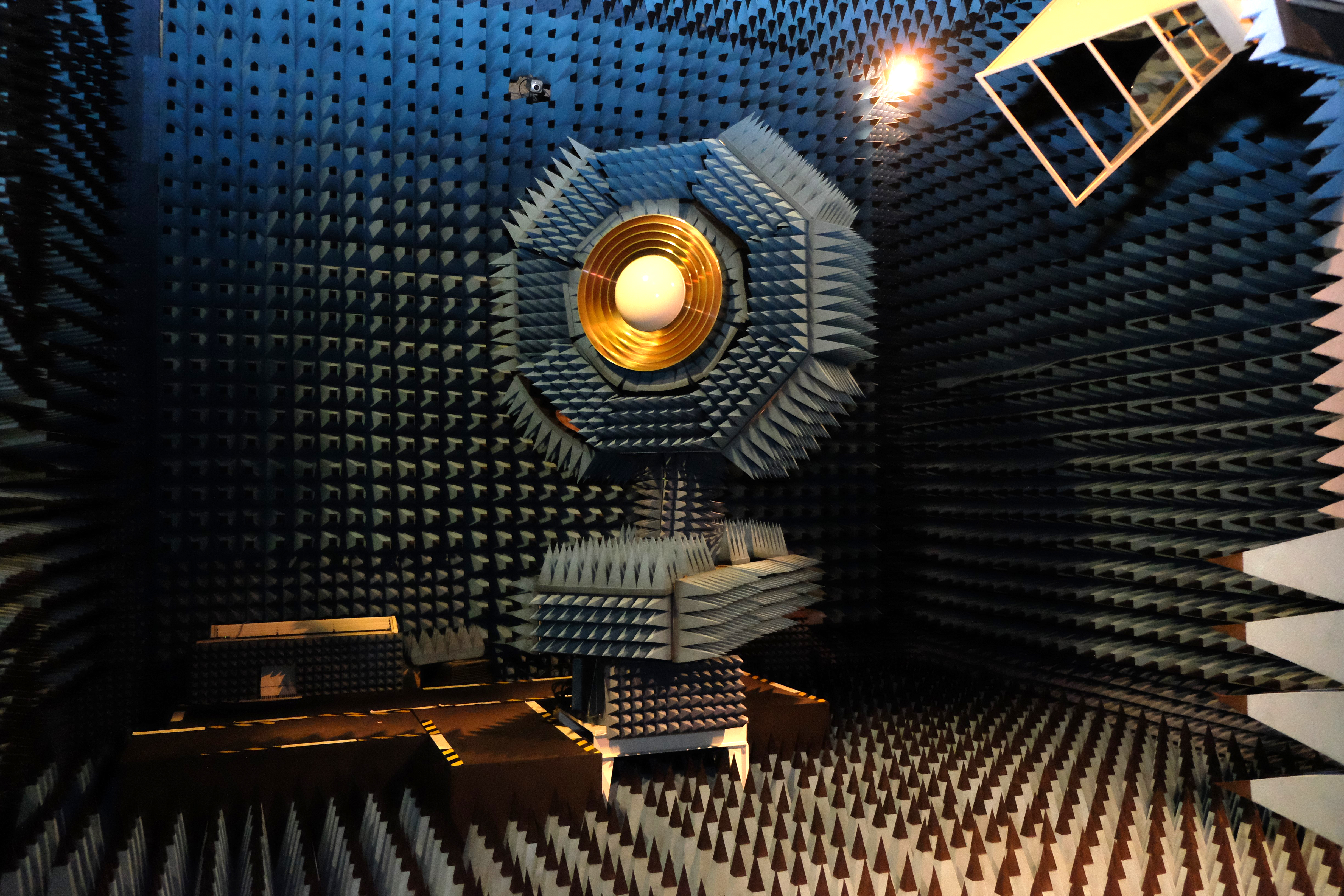
A new ultra-wideband receiver, shown here in a testing chamber, was installed on CSIRO’s Parkes radio telescope in 2018. Credit: CSIRO
Professor Naomi McClure-Griffiths from the Australian National University spent over 2000 hours observing the Milky Way using the Parkes telescope for the Southern Galactic Plane Survey and the Galactic All Sky Survey.
“Parkes was the very first telescope I visited as a student and it has remained a constant companion throughout my career,” Professor McClure-Griffiths said.
“I have exploited its incredible sensitivity to reveal the Milky Way’s interstellar gas in all its glory.
“As far as telescopes go, Parkes was my first love – a love that has been kept alive through CSIRO's outstanding instrumentation on this grand icon of radio astronomy.
“Parkes is as much a marvel of engineering now as it ever was.”
The Mayor of Parkes Shire Council, Councillor Ken Keith OAM, said the Parkes community in Central West NSW is very proud of the telescope.
“It holds a special place in all of our hearts,” Cr Keith said.
“The telescope has attracted an array of talented staff throughout its years, embedding a base of scientific and intellectual knowledge and culture within our region which has in turn further stimulated a scientific interest within the broader community and inspired our young citizens.”
Cr Keith said Parkes’ representation in the hit 2000 Australian movie The Dish enhanced Australia’s interest in the telescope, and the important role it has played throughout history.
“The telescope has certainly cemented its position as an iconic attraction for not only our community, but has gained worldwide attention, and has been pivotal to the growth of the Parkes Shire visitor economy,” Cr Keith said.
Visitors are welcome to CSIRO’s Parkes Observatory, which is open with COVID-19 precautions in place. For more information see www.csiro.au/parkes.
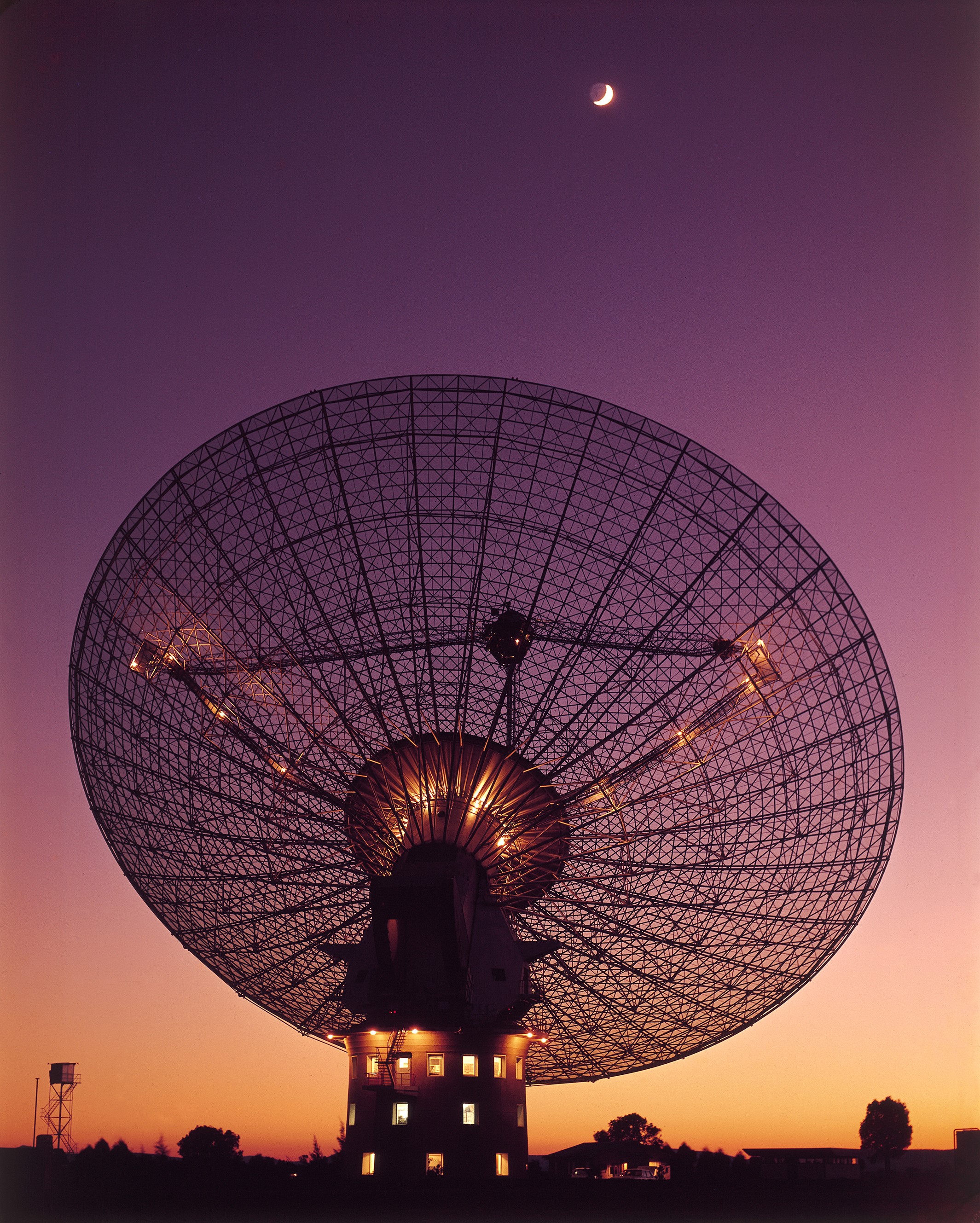
CSIRO's Parkes radio telescope tracking the Moon during a practice run in 1969 prior to the landing. Credit: CSIRO
CSIRO Parkes radio telescope’s top achievements:
- 1961: Construction of the 64-metre diameter telescope at CSIRO’s Parkes Observatory is completed, an achievement of engineering and technical design.
- 1962: Researchers using Parkes find that our Galaxy has a magnetic field a million times weaker than Earth’s magnetic field.
- 1968: Astronomers using Parkes detect pulsar signals, just weeks after UK researchers announce the discovery of pulsars.
- 1969: Parkes receives television signals from the Apollo 11 Moon landing and relay them to a worldwide audience of 600 million people.
- 1973: Parkes is used to discover the Magellanic Stream, a long trail of hydrogen gas flowing from two small neighbouring galaxies called the Large and Small Magellanic Clouds.
- 1982: Researchers using Parkes discover a quasar called PKS 2000-330, the most distant object in the Universe known at the time.
- 1998-2003: Astronomers carry out a survey with Parkes that reveals a new spiral arm in our Galaxy.
- 2003: Astronomers using Parkes discover the first known double pulsar system which enables stringent tests of Einstein's Theory of General Relativity.
- 2007: An unexpected burst of radio waves, more recently known as a ‘fast radio burst’, is found using Parkes archival data.
- 2011: Astronomers using Parkes discover a planet, most likely composed of compressed carbon, in orbit around a pulsar that is dubbed the ‘diamond planet’.
- 2018-19: NASA use Parkes to support the Canberra Deep Space Communication Complex in tracking the Voyager 2 spacecraft as it enters interstellar space.
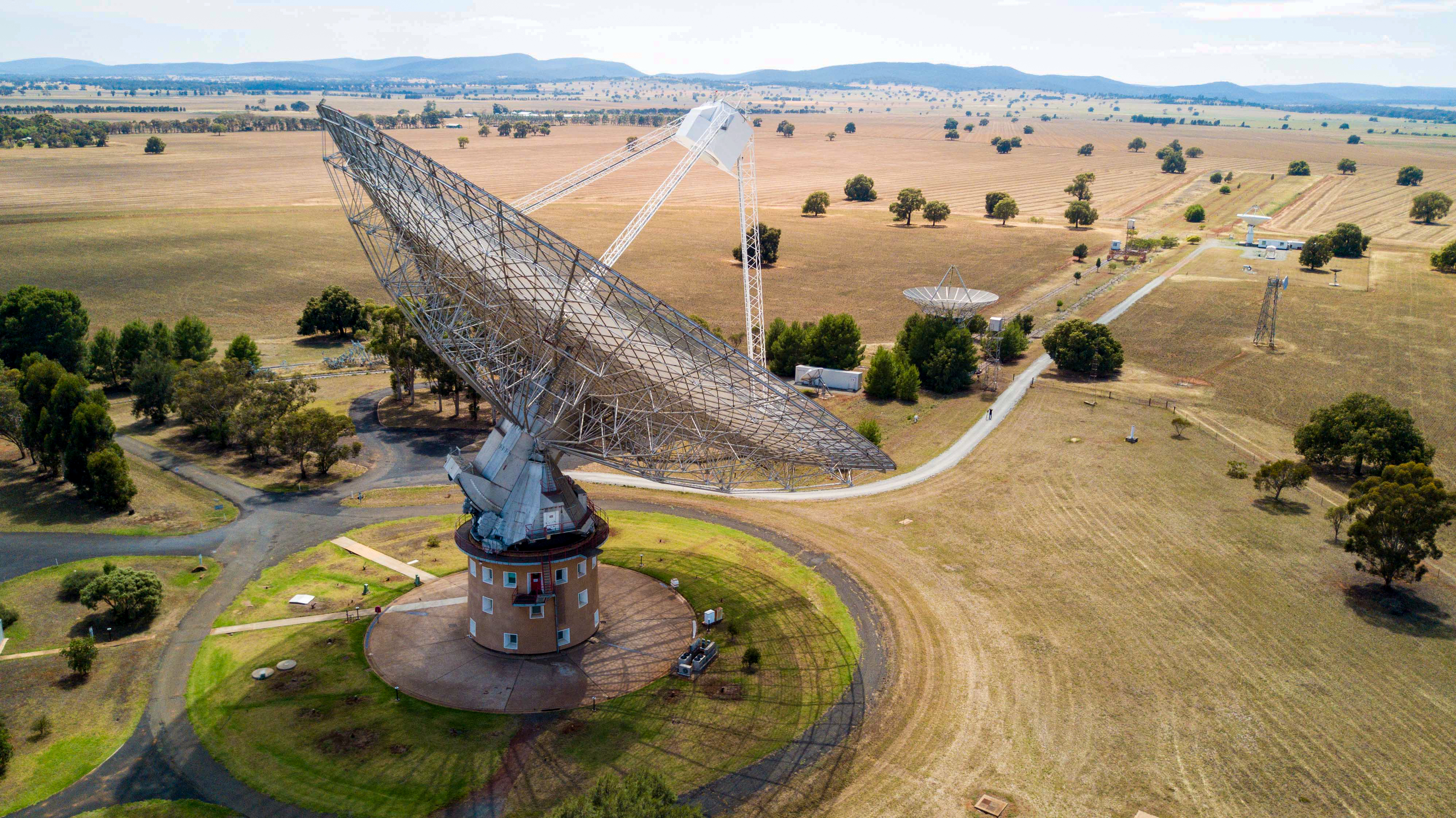
CSIRO's Parkes Radio Telescope. Credit: CSIRO
- Colin Ward. Parkes radio telescope construction. February 11th, 2011. CSIROpedia. Retrieved from: https://csiropedia.csiro.au/parkes-radio-telescope-construction/
- TROVE - National Library of Australia
- Join CSIRO To Celebrate The Apollo 11 Moon Landing At 'The Dish'. Pittwater Online News. Issue 410, June 2019.
- Moon Landing Broadcast Donated To CSIRO By NASA Now Donated To NFSA. Pittwater Online News. Issue 412, July 2019.
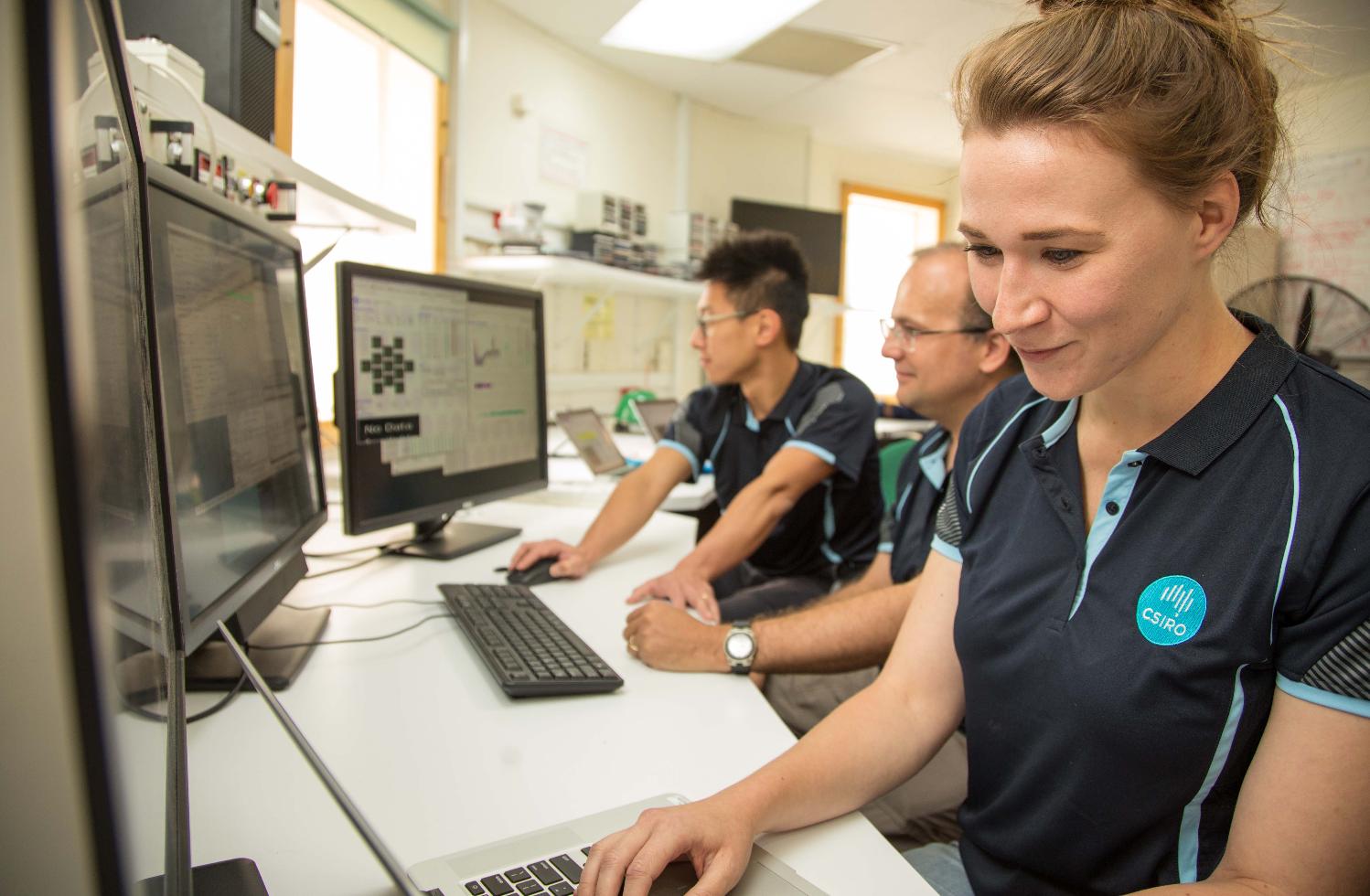
Astronomers observing with CSIRO’s Parkes radio telescope Credit: CSIRO
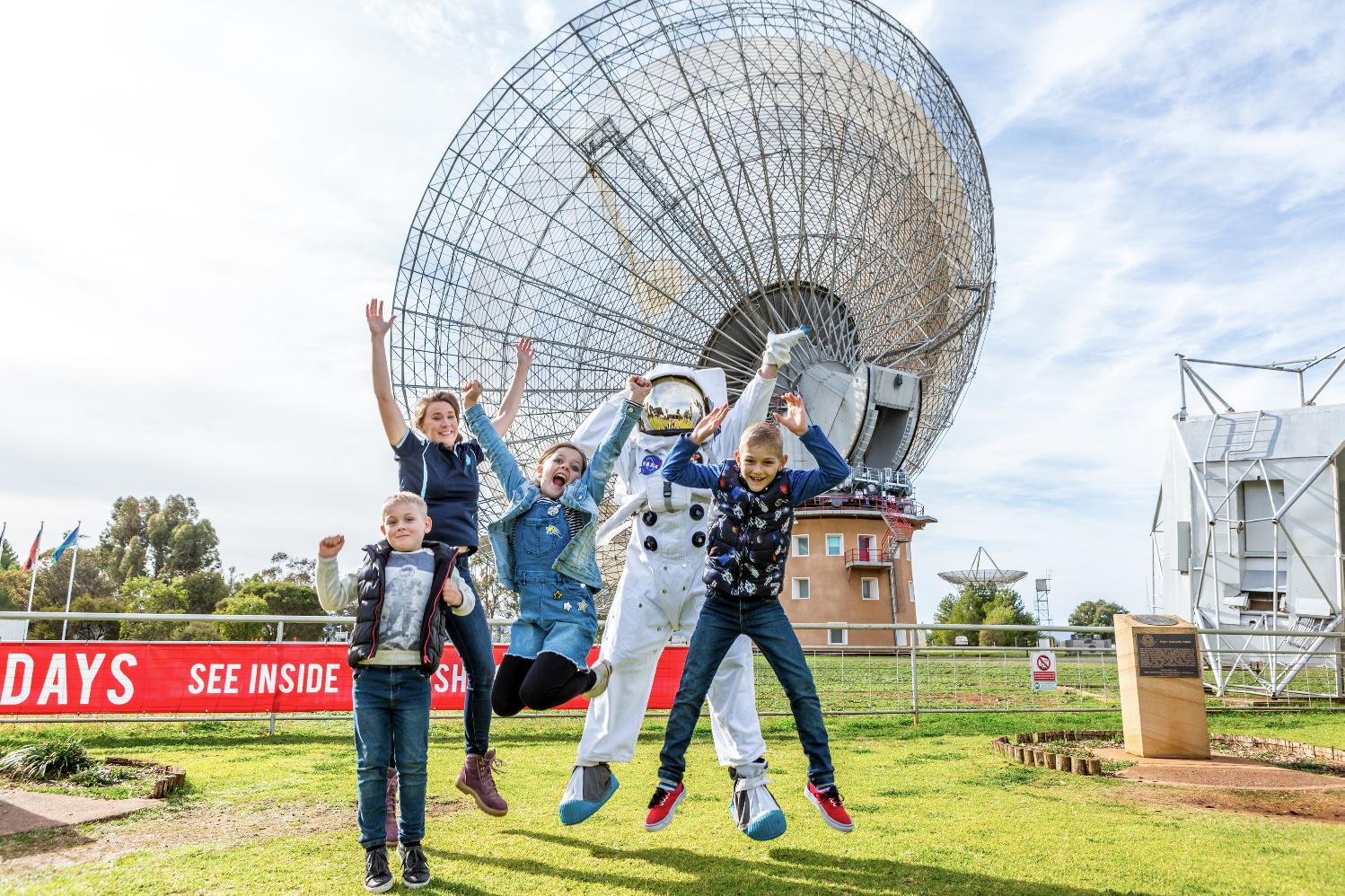
CSIRO's Parkes Open Day in 2019. Credit: CSIRO